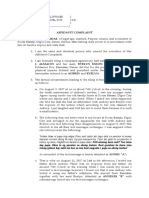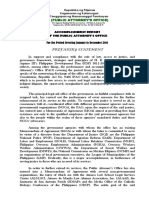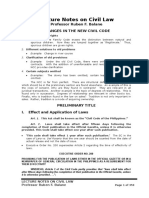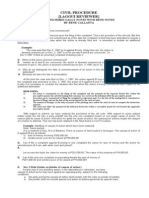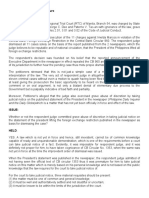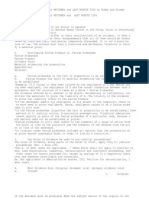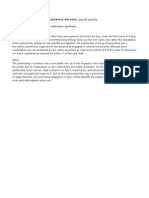Dean Riano Evidence Finals Reviewer
Dean Riano Evidence Finals Reviewer
Uploaded by
Xandee Teh KuizonCopyright:
Available Formats
Dean Riano Evidence Finals Reviewer
Dean Riano Evidence Finals Reviewer
Uploaded by
Xandee Teh KuizonCopyright
Available Formats
Share this document
Did you find this document useful?
Is this content inappropriate?
Copyright:
Available Formats
Dean Riano Evidence Finals Reviewer
Dean Riano Evidence Finals Reviewer
Uploaded by
Xandee Teh KuizonCopyright:
Available Formats
DEAN RIANO EVIDENCE FINALS REVIEWER 1. Memorize Falsus in uno falsus in omnibus Falsus in uno vs.
Falsus in Omnibus means false in one thing, false in everything *interpretation is not strict *While the witnesses may differ in their recollections of an incident, it does not necessarily follow from their disagreements that all of them should be disbelieved as liars and their testimonies completely discarded. It is not a positive rule of law. The witness must have a conscious and deliberate intention to falsify a material point. Distinguish Factum Probans vs. Factum Probandum Factum Probandum Factum Probans Ultimate Facts Material evidencing the proposition Hypothetical Existent. Factum probandum is the fact or proposition to be established Factum Probans the facts or material evidencing the fact or proposition to be established *Example: If P claims to have been injured by the negligence of D who denies having been negligent, the negligence of D and the causal connection between such negligence, and the injuries of P taken as a whole = Factum Probandum The evidence offered by P, whether it be object, documentary or testimonial, constitute the materials to prove the liability of D. The totality of the evidence to prove the liability refers to the Factum Probans *If the defendant admits his negligence in his answer to the complaint, there is no more need to prove negligence. Hence, negligence ceases to be a factum probandum in this case. *if the factum probandum signifies the fact or proposition to be established, then matters of 1) judicial notice, 2)conclusive presumptions, 3)judicial admissions cannot qualify as parts of the factum probandum of a particular case, because such matters need not be established or proven. *Factum probandum in civil case refers to the elements of a cause of action from the point of view of the plaintiff and the elements of the defense from the point of view of the defendant. *In criminal cases factum probandum includes all matters that the prosecution must prove beyond reasonable doubt in order to justify a conviction. Can Rules of Evidence be used in non-judicial proceedings? The rules of evidence, being parts of the Rules of Court, apply only to judicial proceedings (Sec. 1 Rule 128) *Sec.4. In what cases not applicable. These Rules shall not apply to election cases, land registration, cadastral, naturalization and insolvency proceeding, and other cases not herein provided for, except by analogy or in a suppletory character and whenever practicable and convenient. Ex. Not applicable in Administrative bodies, CSC, Petition for naturalization, labor cases Best Evidence Rule (Original document rule) (primary evidence rule) Concept i. Original of the document must be produced; When the subject matter of the inquiry is the contents of a document, no evidence shall be admissible other than the original document itself, Exceptions to the rule i. When the original has been lost, or destroyed, or cannot be produced in court, without bad faith on the part of the offeror; ii. When the original is in the custody or under the control of the party against whom the evidence is offered, and the latter fails to produce it after reasonable notice; iii. When the original consists of numerous accounts or other documents which cannot be examined in court without great loss of time and the fact sought to be established from them is only the general result of the whole iv. When the original is a public record in the custody of a public officer or is recorded in a public office. *Involves only the contents of a writing. The rule cannot be invoked unless the contents of a writing is the subject of judicial inquiry, in such case; the best evidence is the original writing itself. *Where the issue is the execution or existence of the document or the circumstances surrounding its execution, the best evidence rule does not apply and the testimonial evidence is admissible. *Where the issue is only as to whether such document was actually executed, or exists, or on the circumstance relevant to or surrounding its execution, the best evidence rule does not apply and testimonial evidence is admissible. *The best evidence rule applies only when the purpose is to establish the terms of a writing. When the evidence introduced concerns some external facet about a writing like its existence, execution or delivery without reference to its terms, the rule cannot be invoked. The subject of inquiry
c.
1.
2.
a. b.
1. 2.
3.
4.
3.
a. b. c. d.
4. a.
under the best evidence rule it the CONTENTS of a writing, NOT THE TRUTH thereof. Where the truth is in issue, the hearsay rule will now be involved. Illustrative applications i. 1994 Bar At the trial of ace for the violation of the Dangerous Drugs Act, the prosecution offers in evidence a photocopy of the marked bills used in the buy-bust operation. Ace objects to the introduction of the photocopy on the ground that the Best Evidence Rule prohibits the introduction of secondary evidence in lieu of the original is the photocopy admissible in evidence? Yes, the photocopy of the bills being object evidence is admissible in evidence without violation of the best evidence rule. The rule applies only to documentary evidence and not to object evidence. *The reason for the best evidence rule is the prevention and detection of fraud. *The best evidence rule may be waived if not raised in the trial *If the original be presented in evidence 1) Find a legal excuse for failure 2) present secondary evidence If secondary evidence is to be offered in evidence, like a copy, the proponent has to lay the basis for the admission of the copy of the document. Excuses for not presenting the original When the original has been lost or destroyed or cannot be produced in court, without bad faith on the part of the offeror; When the original is in the custody or under the control of the party against whom the evidence is offered and the latter fails to produce it after reasonable notice When the original consists of numerous accounts or other documents cannot be examined in court without great loss of time and the fact sought to be establish is only the general result of the whole; and When the original is a public record in the custody of a public officer or is recorded in a public office. *How to lay the basis for presenting secondary evidence: a) The offeror must prove the execution and existence of the original document; b) The offeror must show the cause of its unavailability Loss, destruction, or unavailability c) The offeror must show that the unavailability was not due to his bad faith Correct order of proof is as follows Existence, execution, loss, and contents. Due execution and authenticity of the document must be proved either: a) by anyone who saw the document executed or written, or by evidence of the genuiness of the signature or handwriting of the maker. When original is in the custody or control of the adverse party: Laying the basis requires: The original exists. That the said document is under the custody or control of the adverse party; That the proponent of secondary evidence has given the adverse party reasonable notice to produce the original document That the adverse party failed to produce the original document despite the reasonable notice. *Waiver: Failure to object to the parole evidence presented by the adverse party operates as a waiver of the protection of the rule. * The loan may be proved by the photocopy as long as A lays the basis for the introduction of secondary evidence, to wit: a) the existence and due execution of the original, and b) the loss of the original without bad faith on his part. (Sec. 5, Rule 130) Distinction between Best Evidence and parol Evidence Best Evidence Rule Parol Evidence Rule Establishes a preference for the Presupposes the original is original document over secondary available evidence thereof. Precludes the admission of secondary Precludes the admission of evidence if the original document is other evidence to prove the available. terms of a document other than the contents of the document itself for the purpose of varying the terms of the writing. Can be invoked by any litigant to an Can be invoked only by the action whether or not said litigant is a parties to the document and party to the document involved. their successors in interest. 4. Applies to all forms of Applies only to written writing contracts and wills. Define Parol Evidence *Applies to agreements and will. Parol evidence means offering extrinsic evidence that would modify, explain or add to the terms of the written agreement. BUT it is allowed if any of the following are shown: An intrinsic ambiguity, mistake, or imperfection in the written agreement; The failure of the written agreement to express the true intent and agreement of the parties; The validity of the written agreement; The existence of other terms agreed to by the parties or their successors in interest after the execution of the written agreement.
b.
1.
2.
3.
5.
a. b. c. d.
c. And only if it is put in issue in the pleadings. *The rule applies ONLY to contracts which the parties have decided to set forth in writing. When n the terms of an agreement is merely oral, the parol evidence rule should not be applied. *Parol evidence does not apply in oral agreements, public writing, private writing, express trust (although parol evidence applies to wills. d.
2)
6.
Testimonial Evidence Adverse party Read Sec. 6. Loss, Destroyed, Unavailable Originals (Sec 5) *Showing that the original document is in the custody or under the control of the adverse party does not ipso facto authorize the introduction of secondary evidence to prove its contents. The party who seeks to present secondary evidence must lay a basis for its introduction. Laying the basis: That the original exists; That the document is under the custody or control of the adverse party; That the proponent of secondary evidence has given the adverse party reasonable notice to produce the original document; That the adverse party failed to produce the original document despite the reasonable notice. How to notify: motion for the production of the original or by subpoena duces tecum, provided that the party in custody has sufficient time to produce it. After the foundational requirement for the introduction of secondary evidence have been complied with, secondarily evidence may now be presented as in the case of loss. This mean that the contents of the document may now be proven by a copy of the document a recital of its contents in some authentic document By testimony of a witness in the order stated (Sec. 5 Rule 130)
a. b. c. d.
The statements were made before the declarant had the time to contrive or devise a falsehood That the statement relates to the circumstances of the startling even or occurrence, or that the statements must concern the occurrence in question and its immediate attending circumstance. Verbal acts Statement accompanying an equivocal act material to the issue, and giving it a legal significance a conduct that is equivocal or ambiguous, one which in itself does not signify anything when taken separately (legal significance) To be admissible, the following requisites must be present: The principal act to be characterized must be equivocal (clear need not be explained); The equivocal act must be material to the issue; The statement must accompany the equivocal act; The statement gives a legal significance to the equivocal act
1) 2) 3) 4)
9.
Exceptions to the hearsay rule, are all hearsay, but are admissible Sec. 36 of Rule 130 ex. Which of the following is hearsay? Hearsay Opinion vs. Hearsay evidence is one that is not An opinion evidence is based on ones personal knowledge based on the personal of others to prove the truth of the knowledge or personal matter asserted in an out-or-court conclusion of the witness based on his skill, training, or experience. Examples of Non-hearsay evidence A statement having probative worth simply by virtue of the fact that it was uttered, if relevant to a material fact inissue is not hearsay and is generally admissible. Where a statement is not offered for the truth of the contents of the conversation, but only to show that it was made, then the statement is not hearsay. For example, a statement that is offered to show its patent falsity, so as to suggest the defendants consciousness of guilt, is NOT hearsay. A statement relating to the state of mind of the declarant and statement relating to the state of mind of the listener, these are not hearsay, but merely constitute circumstantial evidence of an assertion. Ex. To prove by inference the testators state of mind, I am Stalin, Roosevelt, Saddam Hussein, rolled into one A threat against a witness may be offered in evidence to show its impact on the witness and where the reasonableness of a persons conduct is an issue, and out of court declaration may be offered to explain the person's reactions to the declaration. Words offered to prove hearers reaction are admissible when they are offered to show their effect on one whose conduct is at issue.
a.
7. a.
Testimonial evidence topics not found in Rule 130 132 (Sec. 3) Right of witnesses (Sec .6) Cross Exam and Sec. 11 Impeachment of witnesses i. Are the rights of the accused violated in case of compulsory HIV testing? No. There is no testimonial compulsion involved by extracting blood from the accused for testing purposes. Thus, there is no violation of the right to privacy and the right to be presumed innocent. ii. Should DNA evidence be admitted? Yes. The right against self incrimination applies only to testimonial evidence. Extracting blood samples and cutting strands of hair do not involve testimonial compulsion but purely mechanical acts which neither requires discretion or reasoning. (Tijing v. Court of Appeals. iii. The right against self incrimination does not apply to physical and mechanical act. It applies only to testimonial compulsion which is not the case under the facts. iv. Degrading questions although degrading a witness must answer the question if the degrading answer a) is the very fact in issue; or b) refers to a fact from which the fact in issue would be presumed. (Rule 132)
b.
c.
d.
8.
What are the elements of a dying declaration? #3 exam *Must comply with the following foundational elements 1. That the declaration is one made by a dying person; 2. That the declaration was made by said dying person under the consciousness Of impending death 3. That the declaration refers to the cause and circumstances surrounding the death of the declarant and not of anyone else; 4. That the declaration is offered in a case where the declarants death is the subject of inquiry; 5. The declarant is competent as a witness had he survived; 6. The declarant should have died. Note: must refer to the death of the declarant, not merely injuries. *If the declarant survives HIS DECLARATION MAY BE ADMISSIBLE AS PART OF THE RES GESTAE. *The former rule embodied in Supreme Court decisions, which declared that a dying declaration is offered in a criminal case for homicide, murder, or parricide wherein the declarant is the victim, no longer holds true. As amended Parts of the Res Gestae Literally means things done. Res Gestae is the startling event of which the spontaneous statement is only a part of. The use of res Gestae in the Philippines is limited to two matters: Spontaneous statements That there is a startling occurrence taking place; That statements were made while the event is taking place or immediately prior to or subsequent thereto;
Independent relevant statement: The newspaper clipping is admissible as non-hearsay if offered for the purpose of showing that the statement of X was made to a reporter regardless of the truth or falsityof the statement. If it is relevant, it is admissible as an independent relevant statement (non hearsay) It would be hearsay if offered to prove the truth that x was the robber. Exception to the Hearsay Rule: 1. Dying Declarations 2. Declaration against interest 3. Act or declaration about pedigree 4. Family reputation or tradition regarding pedigree 5. Common reputation 6. Parts of the res Gestae 7. Entries in the course of business 8. Entries in official records 9. Commercial lists 10. Learned treatises 11. Testimony or deposition at a former trial Dying Declarations *must be impending, near, and certain. Declaration about pedigree *The declaration about pedigree may be received in evidence if the relationship is shown by evidence other than the declaration. The word pedigree includes relationship, family genealogy, birth, marriage, death, the dates when and the places where these facts occurred, and the names of the relatives. It also embraces facts of family history intimately connected with pedigree. Entries in the course of business. Elements: Entries were made at, or near the time of the transactions Such entries were made in the regular course of business The person making the entries was in a position to know the facts stated in the entries. The person making the entries did so in a position to know the facts stated in the entries
1) a. b.
a) b) c) d)
e) f)
The person making the entries did so in his professional capacity, or in the performance of duty and in the regular course of business The person making the entry is now dead or unable to testify.
by and amended pleading are considered extra judicial admission
Declarations against Interest Ex. A statement by the debtor before he died that he owes the creditor a sum of money, or an oral acknowledgment by the principal that he received the money previously entrusted to his agent, are clear declarations against the interest of the person making it. Note that declaration against interest made by the deceased, or by one unable to testify, is admissible even against the declarants successors in interest or even against third person. Common reputation While common reputation in the community may establish a matter of public or general interest, marriage or moral character, it CANNOT establish pedigree. This is established by reputation in the family and not in the community. Commercial Lists and the Like Must be made by persons engaged in that occupation and are generally used and relied upon by them and those lists and reports are published. Learned Treaties. History books, published finding of scientists fall within this exception IF the subject testifies to the expertise of the writer of if the court takes judicial notice of such fact. Testimony or Deposition at a Former Proceeding. The testimony is one given in a former case or proceeding or administrative, involving the same parties and the same subject matter. The testimony was given by one who is now dead or unable to testify. Said testimony may be given in evidence against the adverse party provided the latter had the opportunity to cross-examine the witness who gave the previous testimony. Waiver The rules of evidence may be waived. The rules are established for the protection of the parties. Except if the rule waived by the parties has been established by law on grounds of public policy. Matters need NOT be proved (ISA-JP) Immaterial allegations Facts admitted or not denied provided they have been sufficiently alleged (Rule 8) Agreed and Admitted facts Facts subject to Judicial Notice Facts legally Presumed Section 4. JUDICIAL ADMISSION is and admission, verbal or written, made by a party in the course of the proceedings. Elements The same must be made by a party to the case The admission must be made in the course of the proceedings in the same case, and There is no particular form for an admission, it may either be written or verbal. Judicial Admissions may be made in Pleadings filed by the parties, In the course of trial either verbal or written manifestations or stipulations In other stages of judicial proceedings as in the pre trial of the case Admissions obtained through depositions, written interrogatories or requests for admissions.
before the judgment of conviction becomes final, but such plea of guilty later withdrawn is not admissible in evidence againt the accused who made the plea. It is not even considered an extra judicial admission Disqualification by reason of Marital privilege (sec. 24 (a) Can be claimed whether or not the other spouse is a party to the action Can be claimed even after the marriage is dissolved Applies only to confidential communications between the spouses The married person is on the stand but the objection of privilege is raised when confidential marital communication is inquired into.
Disqualification by reason of Marriage (sec. 22) Can be invoke only if one of the spouses is a party to the action Applies only if the marriage is existing at the time the testimony is offered Constitutes a total prohibition for or against the spouse of the witness The objection would be raisedon the ground of marriage. The married witness would not be allowed to take the stand at all because of the disqualification. Even if the testimony is for or against the objecting spouse, the spouse-witness cannot testify.
Disqualification by reason of marriage (spousal immunity) Take note of the ff. Judicial admissions vs. Extra-judicial admissions Competence vs Relevance Best Evidence Rule Real Evidence definition (replica offered as evidence) Parol evidence would not be objected if the ambiguity was put in issue in the pleadings Laying the basis for the offer of a photocopy of a contract. Originals Expert testimony of a promissory note Credibility defined refers to worthiness of belief. Chain of custody When may an ordinary witness testify as to his opinion? When may parol evidence be allowed? How do you lay the basis for introduction of secondary evidence when a) original is lost b) ht original is in the custdy of the adverse party. How to impeach testimony of a witness, definition
1) 2) 3) 4) 5)
1) 2) 3)
1) 2) 3) 4)
Judicial admissions can be made by either a party or counsel. Judicial admission may be contradicted only when it is shown that 1. It was made through palpable mistake or 2. That no such admission was made.
Remedy of a party who gave a judicial admission: In case of written judicial admission motion to withdraw the pleadings, motion, or other written instrument containing such admission. Judicial admissions are always conclusive upon the admitter and do not require formal offer as evidence, unlike in the case of extra-judicial admissions. Rule on dismissed pleadings Admissions made in pleadings that have been dismissed are merely extrajudicial admission. Admissions in civil cases Admissions in a pleading which had been withdrawn or superseded Admissions in criminal cases Admissions during arraignment may be withdrawn at any time
You might also like
- Maintenance and Peace and Order Is A Police FunctionDocument39 pagesMaintenance and Peace and Order Is A Police FunctionFerdinand VillanuevaNo ratings yet
- Duties and Responsibilities of GuardsDocument2 pagesDuties and Responsibilities of GuardsXandee Teh Kuizon67% (6)
- Affidavit Complaint - AlmacinDocument2 pagesAffidavit Complaint - AlmacinNeraw Selarom Oirosnob0% (1)
- Criminal Law - FestinDocument35 pagesCriminal Law - FestinDavid StrongvilleNo ratings yet
- Doctrines: Civil Law of The PhilippinesDocument157 pagesDoctrines: Civil Law of The PhilippinesGABRONINO CATHERINENo ratings yet
- Criminal Law Finals ReviewerDocument58 pagesCriminal Law Finals ReviewerDinn Glea Marie CadayNo ratings yet
- Application Form PSSUPT ENTRYDocument3 pagesApplication Form PSSUPT ENTRYlance corporalNo ratings yet
- ACCOMPLISHMENT REPORT For 2011 PDFDocument31 pagesACCOMPLISHMENT REPORT For 2011 PDFAlinaida MKNo ratings yet
- Few Liners Juris - Persons and Family RelationsDocument2 pagesFew Liners Juris - Persons and Family RelationsRecobdNo ratings yet
- 2016 Criminal Law Bar ExaminationsDocument5 pages2016 Criminal Law Bar ExaminationsFrancis Chu FloresNo ratings yet
- Law 2 AwithoutansDocument10 pagesLaw 2 AwithoutansChristian Abu100% (1)
- Mid-Term Examiantion in Remedial Law Review IDocument3 pagesMid-Term Examiantion in Remedial Law Review IJohnNicoRamosLuceroNo ratings yet
- CrimRev Notes - Book IDocument34 pagesCrimRev Notes - Book IAgnes Bianca MendozaNo ratings yet
- Criminal Law Book 2 Course OutlineDocument2 pagesCriminal Law Book 2 Course OutlineAlviaAisaMacacuaNo ratings yet
- Zenaida Saddul VsDocument9 pagesZenaida Saddul VsAlan BuenaventuraNo ratings yet
- Pomoly Bar Reviewer Day 2 PM RemDocument84 pagesPomoly Bar Reviewer Day 2 PM RemRomeo RemotinNo ratings yet
- Balane Civil Law Reviewer - FinalDocument359 pagesBalane Civil Law Reviewer - FinalJames CruzNo ratings yet
- Samplex CompilationDocument3 pagesSamplex CompilationZyra C.No ratings yet
- Fundamental Principles of LaborDocument3 pagesFundamental Principles of LaborKristina Marinela G. RamosNo ratings yet
- Dokumen - Tips Crimpro Finals Reviewer 2docxDocument129 pagesDokumen - Tips Crimpro Finals Reviewer 2docxKim Jan Navata BatecanNo ratings yet
- Remedial Law) Civil Procedure) Notes of Rene Callanta) Made Early Part of 2000 (Est) ) 123 PagesDocument118 pagesRemedial Law) Civil Procedure) Notes of Rene Callanta) Made Early Part of 2000 (Est) ) 123 PagesbubblingbrookNo ratings yet
- Commercial MCQDocument3 pagesCommercial MCQeinsteinspyNo ratings yet
- Criminal Law Review Questions Wo AnswersDocument5 pagesCriminal Law Review Questions Wo Answersapi-241505258No ratings yet
- Taxation Law in Bar Exam 2022 Coverage 1Document5 pagesTaxation Law in Bar Exam 2022 Coverage 1Aubrey CortezNo ratings yet
- Civil Procedure 1 Syllabus Departmental 2024-2025 REVISED AS OF 23 JULY 2024Document25 pagesCivil Procedure 1 Syllabus Departmental 2024-2025 REVISED AS OF 23 JULY 2024Jaime LunaNo ratings yet
- Tita L NotesDocument14 pagesTita L NotesGelo MVNo ratings yet
- Taxation LMT by Atty. LoanzonDocument13 pagesTaxation LMT by Atty. LoanzonDeon marianoNo ratings yet
- Civil Law Review IIDocument25 pagesCivil Law Review IIbile_driven_opusNo ratings yet
- De La Salle University College of Law: Lasallian Commission On Bar Operations 2018Document80 pagesDe La Salle University College of Law: Lasallian Commission On Bar Operations 2018Jazib ZainabNo ratings yet
- 5 Fernando U. Juan v. Roberto U. JuanDocument3 pages5 Fernando U. Juan v. Roberto U. JuanJohn Robert BautistaNo ratings yet
- Criminal Law MCQ (1-10)Document3 pagesCriminal Law MCQ (1-10)einsteinspy100% (1)
- Spec Proc Syllabus 1Document6 pagesSpec Proc Syllabus 1Martin EspinosaNo ratings yet
- Syllabus Evidence 2015Document4 pagesSyllabus Evidence 2015Kristian CaumeranNo ratings yet
- Pil MCQ 2Document5 pagesPil MCQ 2Pauline Vistan GarciaNo ratings yet
- 2018 Syllabus Pol Pil PDFDocument110 pages2018 Syllabus Pol Pil PDFRatio DecidendiNo ratings yet
- Revised Penal Code Memorize ProvisionDocument4 pagesRevised Penal Code Memorize ProvisionSweet Karrah Salazar-CorveraNo ratings yet
- Remedial Law MCQDocument2 pagesRemedial Law MCQJon Frederick DiñoNo ratings yet
- Claw 2 Q and ADocument10 pagesClaw 2 Q and AJed DizonNo ratings yet
- Corporate Income Taxation PDFDocument73 pagesCorporate Income Taxation PDFmaeNo ratings yet
- Amurao Recitation Questions: Next Meeting Next MeetingDocument19 pagesAmurao Recitation Questions: Next Meeting Next MeetingvalkyriorNo ratings yet
- Must Read Juris Political LawDocument47 pagesMust Read Juris Political LawBen DhekenzNo ratings yet
- Adoption: Report By: Mark Rainer Y. LozaresDocument26 pagesAdoption: Report By: Mark Rainer Y. LozaresMark RyeNo ratings yet
- Transcript - (Law - On - Sales) Final CompleteDocument21 pagesTranscript - (Law - On - Sales) Final CompleteMaricrisNo ratings yet
- TOPIC: Matters That Do Not Need To Be Proven by EvidenceDocument5 pagesTOPIC: Matters That Do Not Need To Be Proven by EvidenceRia Evita RevitaNo ratings yet
- Political Law Jurist Lecture NotesDocument10 pagesPolitical Law Jurist Lecture NotesRio AborkaNo ratings yet
- CrimDocument6 pagesCrimMarinel June PalerNo ratings yet
- Labor Trending 2017 PDFDocument15 pagesLabor Trending 2017 PDFChaNo ratings yet
- Taxation Law Bar Questions 2017Document7 pagesTaxation Law Bar Questions 2017manol_salaNo ratings yet
- DE VERA, Paul Nichol R. LLB-1A Criminal Law 1: Less Grave Felonies Penalties InterpretationDocument1 pageDE VERA, Paul Nichol R. LLB-1A Criminal Law 1: Less Grave Felonies Penalties InterpretationBrent Christian Taeza Torres100% (1)
- (People v. Macasling, GM, No. 90342, May 27,1993Document7 pages(People v. Macasling, GM, No. 90342, May 27,1993TrexPutiNo ratings yet
- May Was Crossing The Street When She Was AccidentaDocument2 pagesMay Was Crossing The Street When She Was AccidentaDoreen Denise RodriguezNo ratings yet
- Feb 2 RA 11479 Anti Terrorism Act of 2020 Atty FloresDocument47 pagesFeb 2 RA 11479 Anti Terrorism Act of 2020 Atty FloresRomel AtanacioNo ratings yet
- A.M. No. 19-10-20-SC 2019 Proposed Amendments To The 1997 Rules of Civil ProcedureDocument42 pagesA.M. No. 19-10-20-SC 2019 Proposed Amendments To The 1997 Rules of Civil ProcedureJoseph Eliezer HerreroNo ratings yet
- EVID First Batch Digest 1Document10 pagesEVID First Batch Digest 1Beya AmaroNo ratings yet
- Exceptions To The Hearsay Rule QuestionnaireDocument3 pagesExceptions To The Hearsay Rule QuestionnaireAndrei ArkovNo ratings yet
- Civil Procedure: I. COMPLAINT (In Some ActionsDocument3 pagesCivil Procedure: I. COMPLAINT (In Some ActionsKris Razo0% (1)
- Riano BAR NotesDocument10 pagesRiano BAR NotesGenevieve PenetranteNo ratings yet
- Remedial Tip by RianoDocument8 pagesRemedial Tip by RianoakjdkljfakljdkflNo ratings yet
- Dean Riano Evidence Finals ReviewerDocument10 pagesDean Riano Evidence Finals ReviewerZaira Gem Gonzales100% (1)
- Evidence ReviewerDocument9 pagesEvidence ReviewerChris EspritNo ratings yet
- My Law School Chronicles: Dean Riano Evidence Finals Reviewer and Last MINUTE TIPS by Bimby and KloweeDocument10 pagesMy Law School Chronicles: Dean Riano Evidence Finals Reviewer and Last MINUTE TIPS by Bimby and KloweeHuehuehueNo ratings yet
- PHILIPPINE LAW SCHOOL: Take Home Quiz in Labor Law ReviewDocument1 pagePHILIPPINE LAW SCHOOL: Take Home Quiz in Labor Law ReviewXandee Teh KuizonNo ratings yet
- Vancil vs. BalmesDocument2 pagesVancil vs. BalmesXandee Teh KuizonNo ratings yet
- Parol Evidence RuleDocument1 pageParol Evidence RuleXandee Teh KuizonNo ratings yet
- Facts:: HUNG-MAN-YOC, in The Name of KWONG-WO-SING, Plaintiff-Appellee, KIENG-CHIONG-SENG, ET AL., Defendants-AppellantsDocument1 pageFacts:: HUNG-MAN-YOC, in The Name of KWONG-WO-SING, Plaintiff-Appellee, KIENG-CHIONG-SENG, ET AL., Defendants-AppellantsXandee Teh KuizonNo ratings yet
- Cambaliza vs. Cristal-TenorioDocument1 pageCambaliza vs. Cristal-TenorioXandee Teh KuizonNo ratings yet
- Five J Taxi vs. National Labor Relations CommissionDocument1 pageFive J Taxi vs. National Labor Relations CommissionXandee Teh KuizonNo ratings yet
- Benefits, Barangay, EmployeesDocument122 pagesBenefits, Barangay, EmployeesXandee Teh KuizonNo ratings yet
- German Management and Services v. Court of AppealsDocument1 pageGerman Management and Services v. Court of AppealsXandee Teh KuizonNo ratings yet
- Grand Union Supermarket, Inc. and Nelia Santos Fandino vs. Jose J. Espino JR., and The Honorable Court of AppealsDocument1 pageGrand Union Supermarket, Inc. and Nelia Santos Fandino vs. Jose J. Espino JR., and The Honorable Court of AppealsXandee Teh KuizonNo ratings yet


